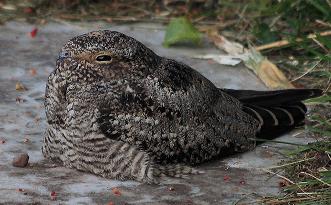Nighthawk
Common nighthawks, part of the nightjar
family, are very acrobatic, slim winged birds often seen high
in the air.
Identification and Pictures of Nighthawk Bird
(Chordeiles minor)
 Nighthawks
are gray or gray-brown birds, about 8 1/2 to 10 inches.
They have
large eyes, short bills, small feet, and long pointed
wings with broad white bars. The bill is surrounded by stiff feathers called rictal bristles
which help it catch flying insects. When they are at
rest the wing tips extend past the tail. Their dead leaf
pattern camouflages them when resting on the ground. The
male has a white throat and white bar across the notched
tail. Nighthawks
are gray or gray-brown birds, about 8 1/2 to 10 inches.
They have
large eyes, short bills, small feet, and long pointed
wings with broad white bars. The bill is surrounded by stiff feathers called rictal bristles
which help it catch flying insects. When they are at
rest the wing tips extend past the tail. Their dead leaf
pattern camouflages them when resting on the ground. The
male has a white throat and white bar across the notched
tail.
Photo by Keith
Lee. The camera I use is the Canon
EOS 40D. Visit All-birds store
Nighthawks are also called “mosquito
hawks," "goatsuckers,” “bull bats,” and “night
jars”. The name Goatsucker was given to them in
ancient times when goat herders saw the birds flying over their
flocks with open mouths. The birds were catching insects
but the myth developed that they were sucking milk from the
goats.
Sound
Their call is a nasal peer or pee-ick normally
heard in flight.
Listen to sound
Preferred Habitat
They range across the U.S. in summer. In
winter they migrate to South America, often in huge flocks
which may contain hundreds or thousands of birds. They
are often seen in open country from mountains to
lowlands. They like treeless plains, and open pine
woods. They may be seen sitting on the ground, a roof,
or a fence post with their eyes closed, or flying high in the
air at mid day, but they prefer dusk. Males do an aerial
display where they dive, then swoop up making a deep booming
sound with their wings.
Breeding and Nesting
Nighthawks usually nest on the bare ground,
laying 2 cream or whitish colored eggs, with purplish-gray or
olive-brown markings, in sand, gravel, leaves, or on a
rock. In cities they may lay their eggs on a roof.
The eggs are incubated mostly by the female for 18 to 20
days. Both parents will care for the young, which will
fledge in around 20 days. The young birds will be on
their own in 25 to 30 days.
Food
Nighthawks catch flying insects such as mosquitoes, flying ants,
moths, or beetles, out of the air. They prefer feeding
at dawn or dusk but will forage at night with a bright moon or
street light.
To learn about other favorite
birds click here.

|
